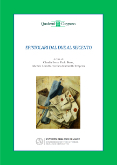"Me perdonne mio mal schritto". L'italiano delle lettere di Jan Brueghel I a Federico Borromeo ed Ercole Bianchi (1596-1624)

Pubblicato 22.12.2018
Parole chiave
- Heteroglossia,
- Italian Art Language,
- Jan Brueghel the Elder,
- Ambrosiana Library,
- Italian letters
Abstract
The Flemish painter Jan Brueghel the Elder wrote almost 80 letters in Italian, all conserved at the Ambrosiana Library of Milan and published for the first time in 1868. These letters were sent between 1596 and 1624 to Cardinal Federico Borromeo and Ercole Bianchi, the latter a famous collector who formed part of Borromeo’s entourage. Cardinal Borromeo and Ercole Bianchi were not only Brueghel’s friends but also two of his most important patrons, for whom he produced many works, as the letters in the Ambrosiana Library testify. Many of the letters are not autographs because in conducting much of his correspondence with Borromeo and Bianchi, Brueghel made use of secretaries, the most important of whom was Peter Paul Rubens, a cultured polyglot as well as an artist. Written entirely in Italian, Brueghel’s letters provide precious evidence of the linguistic correspondences between Flemish and the Italian spoken in seventeenth-century Milan. The paper investigates the pre-eminent lexical features of Brueghel’s Italian, which the painter himself described as mal schritto (poorly written) owing to the many grammatical mistakes. Despite the deficiency of his Italian, Brueghel’s rich art vocabulary is testament to the depth of his knowledge of the principles, practices and lexicon of the Italian Renaissance. The combination of technical terms with grammatical errors makes Brueghel’s letters particularly fascinating from the perspective of Italian linguistic history.
